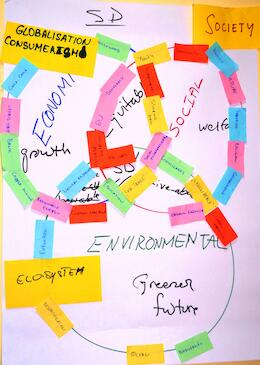Toolbox — For Training and Youth Work
All new tools in your inbox: Be the first to know about new tools for learning with our e-mail notifications.
Simulation Exercise, Exercise, Info session
Basics of sustainable development
This is an interactive tool aiming to creatively present the general concept of sustainable development. Through group work and reflection, participants understand the links among the 3 pillars of sustainable development.
Aims of the tool
The aim of the tool is to deliver knowledge and understanding about Sustainable development.
Description of the tool
Step by step tool description:
1. 30 pieces of paper are prepared by writing one word on each (the number of papers is recommended to be double the number of participants).
2. Each participant is randomly given 2 pieces of the prepared papers.
3. Participants are given instructions that all the words in their hands are elements of three different fields. Their first task is to exchange words among them so at the end each participant has in his/her hands two words which form one field (connected)*.
4. The next instruction – “Discuss and form three groups according to relationship/connection among the words in your hands where each group will have one field– three groups; three fields”.
5. Next step is after the three groups are formed each group is to discuss, decide and give a TITLE for the field related to the words they have.
6. After the groups are ready with the titles, each group will present the title and all the words they have.
7. Next step is to distribute the words in three circles (around each group title of the field) according to how close and connected are the words from each field to others. In the circle the words that are less connected to other fields stay distant and the ones which are connected are placed close to the other field that is connected with (see pictures X).
8. After the circles are ready, trainers ask participants to explain distribution of the words in the circle and especially the ones that are linked to the other circles and what the link between the different fields is.
9. After the discussion is opened about the general connections among the fields and if there is a difference if we develop one and neglect another field.
10. After discussion, trainers stick the titles of the fields chosen by the groups to previously prepared flip chart with the three pillars of sustainable development (each title is related to one of the pillars – Environmental, Economic and Social) and present the definition and concept of Sustainable development. (see picture X + you can refer to diagram below and maybe move it within explanation)
* Previously prepared words are provisionally divided in three groups but the division is not very clear. During the discussion participants can distribute words by their own understanding which even gives added value to the tool.
Available downloads:
Disclaimer
SALTO cannot be held responsible for the inappropriate use of these training tools. Always adapt training tools to your aims, context, target group and to your own skills! These tools have been used in a variety of formats and situations. Please notify SALTO should you know about the origin of or copyright on this tool.
Tool overview

http://toolbox.salto-youth.net/1486
This tool addresses
Environment
It is recommended for use in:
Action 1.1 (Youth Exchanges)
Action 4.3 (Training and Networking)
Materials needed:
Colored pieces of paper with words written on them (double the number of participants so each participant can have two pieces of paper); Markers and ½ A4 papers for the titles; Flipchart; masking tape or blutac;
Duration:
90 min
Behind the tool
The tool was created by
Ognian Gadoularov (Bulgaria) and Iyad Aljaber (Jordan)
in the context of
Training course “Environment, Sustainability and Youth – entrepreneurship and development in rural areas” (BG13/A3.1.2/270/R2), 28.10 – 05.11.2013 – Smolyan, Bulgaria
The tool has been experimented in
Training course “Environment, Sustainability and Youth – entrepreneurship and development in rural areas” (BG13/A3.1.2/270/R2), 28.10 – 05.11.2013 – Smolyan, Bulgaria
The tool was published to the Toolbox by
Ognian Gadoularov (on 14 January 2014)
and last modified
4 December 2013
Comments
No comments have been posted yet.
If you want to comment on this tool, you need to be signed in with your MySALTO account. Sign in now